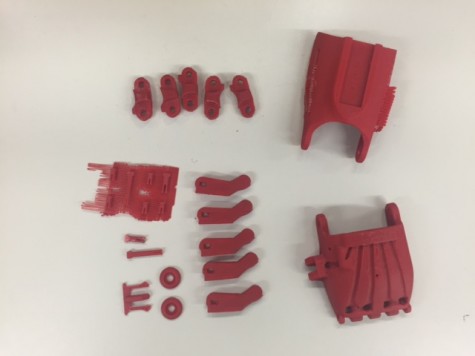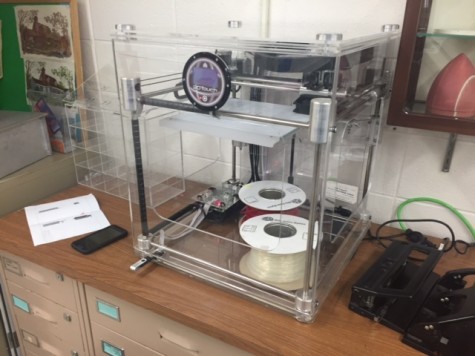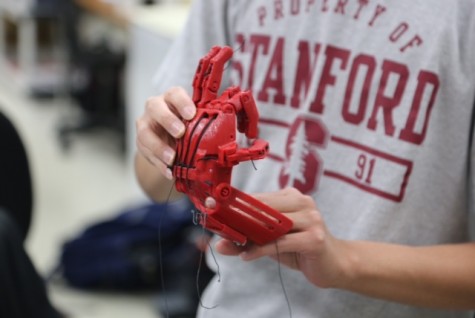Huskie Robotics gives a hand to amputees
January 30, 2016
The mayhem of human-to-human and human-to-machine collaboration creates a steady drumbeat in the science hallways of Naperville North. It’s where some of the brightest minds of the school are set free to create. Amid the hysteria, it’s easy to overlook a group of young engineers hunched around a table arranging and rearranging red pieces of plastic.

They’re all members of the NNHS Robotics Team, and this year they’re helping the team bring new meaning to it’s hashtag: #morethanjustrobots. Layer by plastic layer, they’re trying to help rebuild a life.
Since the fall, the team has been watching diligently as a 3D printer darts to and fro — they’re creating not a gear or wheel for remotely controlled chaos, but an artificial hand for a real, live human being.
The group of four freshmen and team leader Brandon John plan to build the synthetic hand for an amputee in need with the help of e-Nabling the Future (e-NABLE), the company that created the design.
John, a junior at Naperville Central with the patience and drive to engineer such an elaborate project, discovered the company on his own several years ago after building his own personal 3D printer.
“I was just looking for something to do because there gets to be a point when you have too many bells and whistles,” John said. “I haven’t actually been able to build a hand because my printer is too small and incompatible with the designs, but I still joined the organization.”
After joining the robotics team at NNHS, John brought the idea to the team, where he recruited freshmen Aditya Ramachandran, Aman Sekhon, Chirag Sirigere and Tarun Vellanki to work on the project.

“I realized that hey, we’ve got a 3D printer. It’s plenty big, and it can do exactly what we need,” John said. “We very quickly realized we can do this, and we’ve been going for it.”
Not only can Huskie Robotics build this hand, but they are essentially doing it for free, according to John. The red plastic hand is completely mechanical, which lowers the price significantly. It will cost the team less than $20 in materials, as opposed to the hundreds or even thousands of dollars usually spent on prosthetics.
The hand will have two major parts: one grabs onto the top of the palm and another attaches to the wrist with strings connecting the two. When the wearer bends and straightens their wrist, it tightens the strings, pulling the fingers closed and open respectively, allowing them to hold certain objects.
Since the fall, the team has been building a test hand to prove that their 3D printer can handle the task. Once completed, the team will send the prototype within the next week to e-NABLE to be approved. It will then be sent in a bulk package with products made by others through the company where it can be given to people in need, possibly even local ones, according to John.
“We have someone in Naperville that is missing a portion of their hand and we are currently working with their doctor to see if this type of device will help them,” John said.

A worldwide organization, e-NABLE was created by Jon Schull, a professor at RIT, in July 2013. According to their website, the nonprofit company is made up of “people who have put aside their political, religious, cultural and personal differences – to come together and collaborate on ways to help improve the open source 3D printable designs for hands and arms for those who were born missing fingers or who have lost them due to war, disease or natural disaster.”
When John first decided to attempt an e-NABLE project, he admitted he underestimated the scope of the work.
“It was just a preseason project to introduce them to robotics that went a lot bigger than it necessarily had to, but it’s great that it did,” John said.
The project has been completely run by the students, according to Mark Rowzee, one of the sponsors of Huskie Robotics.
“What I’m most proud of is that I had no involvement in it. They realized that we have this 3D printer, and we need to teach younger students how to use it,” Rowzee said. “What better way than to engage them in a project that has such an amazing potential to help people.”

Sirigere said the project has brought a deep change to how he sees robotics.
“It feels like we’re helping something bigger than just our team,” Sirigere said. “It’s like helping someone across the world.”
Sekhon is also proud of the help he’s given to those in need.
“It makes me feel like I’m actually contributing in life,” Sekhon said. “I’m excited to see the outcome because it’s a really great feeling knowing that you’re helping somebody out, especially in need of a hand.”
Being given the opportunity to work on this project at such a young age has bonded the freshmen while simultaneously increasing their robotics skills. At the start of the assignment, the students were only beginning to learn how to use the 3D printer.
“It’s been a thrilling experience,” Vellanki said. “I really enjoyed printing out all the pieces and just assembling it. It was a work in progress, and now it’s starting to piece together and look like a real thing that we can use to help someone else.”

Sophomore Melanie Voss, after hearing about the project, said she has a new admiration for the robotics team for bringing a project like this to NNHS.
“I think it’s really great that we’re using the resources we’re lucky enough to have to help people who aren’t as lucky,” Voss said. “It makes me proud to be a part of a school where stuff like this happens.”
Vellanki’s sights are already set on the future.
“As the project goes on, I want to see how many hands we can make,” Vellanki said. “I want to help as many people as I can.”
Rowzee has big hopes for the team. He is already amazed at the talent they’ve shown.
“To see it all put together, flexing like a real hand, is pretty amazing too. Who knows what it might lead to,” Rowzee said. “One or more of them might invent something that helps people in the future based off just this learning experience.”
Written by Lauren Bell and Julia Donofrio.
Reported by Jeff Leu, Kevin Keane, Aditi Prakash, Marina Silva, Nick Bettuzzi and Brandon Morrow.

Joe Gowing • Jan 30, 2016 at 6:08 pm
Nice to see kids contributing like this. Thanks for highlighting this interesting story.